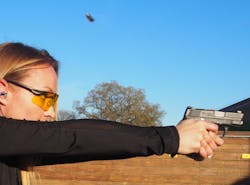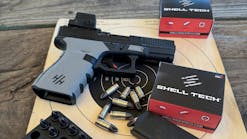Smith & Wesson's M&P Shield...off duty
I recently tested the Smith & Wesson M&P Shield, a lightweight, concealable handgun, suitable for police backup or off-duty carry. My verdict: it proved to be a capable shooter and a 24/7 carry gun. But first, let’s get to stats. The M&P Shield is a 19-ounce polymer striker fired handgun. Its most prominent feature is the fact that it is slimmer than most concealable handguns capable of a duty round. The frame is 0.95 inches wide.
M&P models use polymer for the frame and Melonite treated stainless steel for the barrel and slide. The steel in the Shield is especially corrosion resistant, which is essential for a gun that will be carried against the body. This gun is an ultra-compact in the sense that it is about the same size as many pistols designed for .380 auto, but it fires a bullet widely accepted as a duty caliber. Since I generally wear Tru-Spec 24-7 Series pants and shorts everywhere, it fits in my pocket, along with a couple of magazines without print.
The M&P Shield comes in 9mm or 40 S&W. I picked the 40 as I wanted to get an idea how larger projectiles felt from a small gun. We used Winchester Train & Defend ammo, which sends a 180-grain bullet at 925 fps in short barrel guns. This ammunition is a matched pair of cartridges developed side-by-side. One is for training, the other for carry. The cartridges were designed to be decisive, with moderate recoil. For a law enforcement agency, having training ammunition that feels and shoots exactly like duty ammunition is a great strategy.
Back to the gun
The 40 Smith & Wesson version comes with a 6-round and a 7-round magazine. Although the overall length is 6.1 inches, it has a full 5.3 inches sight radius. The model we tested was the California version, which includes a tactile and visual loaded chamber indicator. Although the manual safety is optional, this version came with one. I am a big fan of matching the duty firearm with the backup firearm. Smith & Wesson has several duty firearm options that match the Shield—the larger ones are only slightly wider. The Smith & Wesson M&P 40 full-sized model has an overall width of 1.2 inches. It has the same feel as the Shield, including the natural 18-degree grip angle. The full sized version has a few more features than the Shield, including front rails and interchangeable palm swells.
When I asked firearm instructors Anthony and Jessica Regalado to model the M&P Shield for photos, they promptly showed up on the range with several of their own M&P handguns. I guess I didn’t have to ask how they felt about M&P’s.
The learning curve
I’m particular about off-duty guns. Most officers don’t practice with them enough, and this gun was designed to shoot. Most polymer guns have metal rails that contact the steel slide. Rather than have full-length rails, the M&P Shield has only four points of contact between the slide and frame. This is an advantage in dusty or muddy environments.
If you ask most officers what they think about their M&P, they will tell you that it fits them well. Smith and Wesson listened to its customers and produces one of the most ergonomic frames in the industry. It’s not just the 18-degree grip angle, either; the width at the web of the hand allows an officer to steer the gun with the thumb and forefinger. Several of my friends are full-time firearms instructors. In their experience, new shooters who arrive on the range with an M&P model tend to have an easier learning curve compared to other brands.
The controls on my Shield are within easy reach. The slide release is easily swept, even with relatively small hands. Most importantly, the web of the hand is able to get a good purchase very close to the axis of the bore. Not only does this make the gun more controllable, it gives every shooter a more natural feel.
The Shield’s magazine release has a wedge shaped ramp just in front of it that is sufficient to prevent accidental activation. It also makes dropping the magazine instinctive, because it’s easy to find. No user that tested this gun had to shift their grip to release the magazine.
The bottom of the magazine is a little wider than the tapered top, like a double stack that tapers into a single stack. The magazines are stainless steel with smoothly ground seams and a grooved portion for rigidity. This is the kind of magazine that’s 100 percent at home in the back pocket. Because of the taper, it was easy to funnel these into the gun. The 7-round version has a little extra bumper space, which can add to a little more purchase for a larger hand.
I should make it very clear that I do not like manual safeties on striker fired guns. We have gotten trigger technology to the point of having smoothness with the initial take-up that rivals the safety of her revolver on an auto. Although the safety on this gun is particularly unobtrusive, it makes its operation a little less instinctive. It is available without the safety. I don’t care for magazine safeties, either. The California version comes with one. It did not interfere with its shootability.
When the M&P line of handguns first came out, the trigger was a little stiff for me. I noticed they have since improved the bearing contact, where the striker is released. It breaks at about 6.5 pounds and, while not a target trigger, is smooth and consistent. The sear reset of this model is short and Smith & Wesson deliberately made it audible. I know several people who are using stock models for competition, primarily for their excellent take up and crisp release.
Winchester provided enough ammunition for us to become familiar with our Shield. The 40 S&W ammunition is a 180-grain FMJ cartridge in the Train configuration, and 180-grain bonded JHP in the Defend version. I have been testing cartridges for years and there are a few things I can tell you about the Train and Defend products we used. First, Winchester has done a great service to defensive shooters everywhere, not just law enforcement. The two cartridges are completely identical in performance, right down to the low flash from a short barrel. This is a critical design feature for this little gun. Second, there is a “sweet spot” for moderate recoil, high-performance cartridges in this weight—Winchester has found it. Third, I have run plenty of Winchester bonded JHP through ballistic gelatin. If I had to sum my testing with this type of bullet from Winchester, I would call it reliable performance.
My catchphrase for this shooting sessions has to be “Brass in the air”. If there was ever a palm sized handgun that can put accurate fire downrange quickly, this is it. There were times when we could fire on a five-yard target and have two expended brass still in the air while a bullet was going downrange.
My M&P Shield could deliver accurate fire at a steady cadence. It handled and shot like a full sized gun. It belongs on the vest, but it’s just as comfortable in kydex and Hawaiian shorts. This is a combat handgun.

Officer Lindsey Bertomen (ret.), Contributing Editor
Lindsey Bertomen is a retired police officer and retired military small arms trainer. He teaches criminal justice at Hartnell College in Salinas, California, where serves as a POST administrator and firearms instructor. He also teaches civilian firearms classes, enjoys fly fishing, martial arts, and mountain biking. His articles have appeared in print and online for over two decades.



